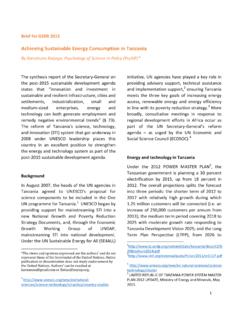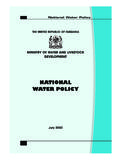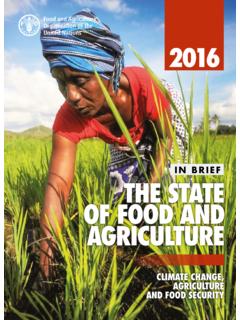Transcription of MODULE 1 GenderandFoodSecurity
1 INTRODUCTIONFood Security, at the individual, household, national, regional,and global levels [is achieved] when all people, at all times, havephysical, social, and economic access to sufficient, safe, andnutritious food to meet their dietary needs and food prefer-ences for a healthy and active (2001)Today the world has enough food to feed everyone,yet an estimated 854 million people worldwideare still undernourished (FAO 2006) (fig. ).1 Poverty not food availability is the major driver of foodinsecurity. Improvements in agricultural productivity arenecessary to increase rural household incomes and access toavailable food but are insufficient to ensure food indicates that poverty reduction and food securitydo not necessarily move in tandem. The main problem islack of economic (social and physical) access to food atnational and household levels and inadequate nutrition (orhidden hunger).
2 Food security not only requires an adequatesupply of food but also entailsavailability, access,andutiliza-tionby all men and women of all ages, ethnicities, religions,and socioeconomic inequalities all along the food productionchain from farm to plate impede the attainment of foodand nutritional security. Maximizing the impact of agricul-tural development on food security entails enhancing women sroles as agricultural producers as well as the primary care-takers of their families. Food security is a primary goal ofsustainable agricultural development and a cornerstone foreconomic and social development, and so this MODULE servesas a road map that indicates how addressing gender in agri-culture development in the other Modules can be optimizedto maximize the impact on food security. Unlike the otherModules, it does not contain thematic notes but insteadguides the reader to Modules that provide more in-depthdiscussions.
3 It also demonstrates the vital and often unac-knowledged role that women play in agriculture, as well ashow their critical role in ensuring sustainable agriculturaldevelopment translates into household-level improvementsin food and nutritional AGRICULTURETO FOOD SECURITYA griculture and food security are inextricably linked (seefig. ). The agricultural sector in each country is dependenton the available natural resources, as well as on nationaland international policy and the institutional environmentthat governs those resources. These factors influence womenand men in their choice of crops and levels of potentialproductivity. Agriculture, whether domestic or international,is the only source of food both for direct consumption andas raw material for refined foods. Agricultural productiondetermines food availability. The stability of access to foodthrough production or purchase is governed by domesticpolicies, including social protection policies and agriculturalinvestment choices that reduce risks (such as droughts) inthe agriculture production cycle.
4 Yet the production of food11 Gender and Food SecurityM O D U L E :01-FSB-Ch01 9/22/08 8:49 AM Page 11is not the only goal of agricultural systems that also producefeed for livestock and fuel (see MODULE 10 for a more in-depthdiscussion). Therefore, demand for and policies related tofeed and fuel also influence food availability and grains are the main source of dietary energy inthe human diet and are more likely to be available throughnational and international markets, even in developing coun-tries, given their storage and transport , vegetables, livestock, and aquaculture products arethe key to micronutrient, that is, vitamins and minerals, suf-ficiency. However, most of these products are more perish-able than grains, so that in the poorest countries where lackof infrastructure, such as cold storage and refrigeratedtransport, predicates short food chains, local agriculturedetermines the diversity of diets.
5 Food security can becomea reality only when the agricultural sector is elements are necessary to achieve food and nutri-tional security as shown in figure These are largelyassigned to women, who play a key role in ensuring foodsecurity and are the focus of this S ROLE IN FOOD AND NUTRITIONALSECURITYA gricultural interventions are most likely to affect nutrition out-comes when they involve diverse and complementary processesand strategies that redirect the focus beyond agriculture forfood production and toward broader consideration of liveli-hoods, women s empowerment, and optimal intrahouseholduses of resources. Successful projects are those that invest broadlyin improving human capital, sustain and increase the livelihoodassets of the poor, and focus on gender Bank (2007b)Women are crucial in the translation of the products of avibrant agriculture sector into food and nutritional securityfor their households.
6 They are often the farmers who culti-vate food crops and produce commercial crops alongsidethe men in their households as a source of income. Whenwomen have an income, substantial evidence indicates thatthe income is more likely to be spent on food and children sneeds. Women are generally responsible for food selectionand preparation and for the care and feeding of are the key to food securityfor their households(Quisumbing and others 1995).In rural areas the availability and use of time by womenis also a key factor in the availability of water for goodhygiene, firewood collection, and frequent feeding of smallchildren. In sub-Saharan Africa transportation of suppliesfor domestic use fetching fuelwood and water is largelydone by women and girls on foot. In Ghana, Tanzania, andZambia women expend most of their energy on load-carryingactivities involving transport of fuelwood, water, and grainfor grinding.
7 Fields dedicated to food crops are often fartherfrom home than those related to cash crops. Because womenmust also perform domestic tasks, they must spend a con-siderable amount of time traveling between their home andthe fields. This burden, together with other domestic and12 MODULE 1: GENDER AND FOOD SECURITYN ationalfoodsecurityrequires both the produc-tion and the ability to import food from globalmarkets to meet a nation s consumption year-round access toan adequate supply of nutritious and safe food tomeet the nutritional needs of all householdmembers (men and women, boys and girls).Nutritionalsecurityrequires that householdmembers have access not only to food, but also tohealth care, a hygienic environment, and knowl-edge of personal hygiene. Food security is neces-sary but not sufficient for ensuring nutritionsecurity. (International Fund for AgriculturalDevelopment [IFAD])China150 India 212 World854 Developing world820 Industrializedcountries 9*Excluding China and IndiaTransitioncountries 25 Sub-SaharanAfrica206 Near East andNorth Africa 38 Latin America/Caribbean 52 Asia/Pacific*162 Figure Undernourished PeopleWorldwideSources:FAO 2006; :01-FSB-Ch01 9/22/08 8:49 AM Page 12reproductive activities, severely constrains the amount oftime available to women (see Modules 9 and 7, particularlyTechnical Note 4 in the latter).
8 As women s time constraintsincrease because of engagement in wage labor and other fac-tors, they will need to build strategic alliances with men tomeet all the needs of the household. In the WIN project(Empowerment of Women in Irrigation and Water ResourcesManagement for Improved Food Security, Nutrition andHealth) in Nepal, one woman trained as a para-veterinarianconvinced her husband to care for their children and per-form other domestic tasks while she made her in the availability of natural resources, due tothe depletion of natural resources and/or impacts of climatechange, can compromise food security by further constrain-ing the time available to women. As discussed in MODULE 10,water degradation and pollution can force women to travelfarther to collect water, reduce the amount they collect, andcompromise hygiene practices in the household. Recogniz-ing women s needs for environmental resources, not onlyfor crop production but also for fuel and water, and build-ing these into good environmental management can releasemore time for women to use on income generation, childcare, and has an additional impact on food securitythrough its impact on health.
9 For example, poorly managedirrigation infrastructures may become a breeding groundfor mosquitoes, and excessive use of groundwater for irriga-tion may compromise water sources needed by women toensure good hygiene practices and clean food preparation,without which children suffer more frequently from diar-rhea and compromised is a major driver of food insecurity, but the twoare not always linked. Poorer households headed by womenhave demonstrated that they often succeed in providingmore nutritional food for their children than those headedby men (Kennedy and Peters 1992). This demonstrates theimportance of gender-based knowledge and roles withregard to food security. Men who lack knowledge aboutMODULE 1: GENDER AND FOOD SECURITY13 SOCIOECONOMICAND POLITICALENVIRONMENTFOOD AVAILABILITY(Trends and levels)ProductionImports (net)Utilization(food, nonfood)StocksChildcareFeeding practicesNutritional educationFood preparationEating habitsIntra-householdfooddistributionFoo d productionIncomesMarketsSocial entitlementsPurchasing powerMarket integrationAccess to marketsHealth carepractices,Hygiene,Water qualitySanitationFood safety andqualityHealth statusHEALTH ANDSANITATIONNUTRITIONALSTATUSFOODCONSUM PTIONE nergy intakeNutrientintakeSTABILITY OF FOODSUPPLIES AND ACCESS(Variability)FOODUTILIZATIONBY THE BODYACCESS TO FOOD(Trends and levels)
10 CARE PRACTICESN ational levelPopulationEducationMacroeconomyPoli cy environmentNatural resource endowmentAgriculture sectorMarket conditionsSubnational levelHousehold characteristicsLivelihood systemsSocial institutionsCultural attitudesFigure Elements in Achieving Food and Nutrition SecuritySource:IFAD, FAO, and WFP :01-FSB-Ch01 9/22/08 8:49 AM Page 13food preparation may not be able to translate food avail-ability into nutritional security for their following sections examine in detail the three keycomponents of food security and show how women s con-tribution to agriculture and its translation into nutritionalsecurity can be SECURITYFood security is essentially built on three pillars: food avail-ability, food access, and food utilization. An individual musthave access to sufficient food of the right dietary mix (qual-ity)at all timesto be food secure. Those who never have suf-ficient quality food are chronically food insecure.












